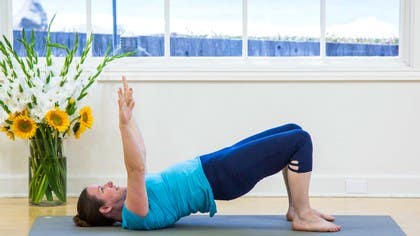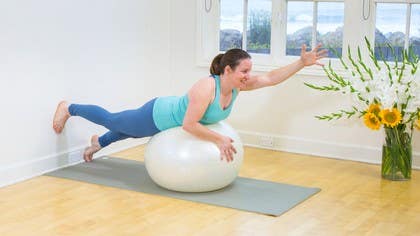Description
About This Video
Transcript
Read Full Transcript
The four main components of public health are breath, movement, alignment, and that doesn't mean alignment of the perfect yoga pose, but more so alignment, how the body is in alignment, and also the piece around education and information, which I feel has two parts to it, sort of this part of, sure, we can learn about public health from someone outside of us, but also what we gain through yoga is this inner wisdom, this awareness that we really build about our own body. A lot of women will feel like, or maybe society in general, kind of has this message towards women that pelvic pain, pelvic discomfort, urinary incontinence, that these are normal things that women just need to deal with as we say when we're getting our period, then it's normal to have that intense pain, and it's not. So a lot of women are living with pelvic pain, and even what's fascinating about the pain piece is that sometimes we feel it in different parts of our body and it's radiating from pelvic floor. So for example, someone might have pain in their bladder that's really similar to a UTI, urinary tract infection, and that pain is actually coming from the pelvic floor. So women will have the bladder removed and the pain is still there.
So it's coming right from pelvic floor and it takes a pelvic floor physio to actually palpate that muscle, the pelvic floor, and then they'll notice, oh, that's where the pain is. The pelvic floor then usually needs to be released and it's really holding on and gripping. Or another example is for myself, and I had really bad low back pain and I just thought this is something that goes along with birthing three children, lifting them up, carrying them, gardening, doing all the things that I do in life, when actually it was coming from pelvic floor. So we now know that most of low back pain can be from hypersonic pelvic floor, which is like a pelvic floor that's too tight. So if you think about a muscle, like say your arm muscle, you can flex that muscle, but then you need to release that muscle.
If you flexed it all day long, it would over tired, it would over tire, it wouldn't work, it would, yeah, you couldn't even pick up a pencil if you kept your muscle flexed the entire time. And pelvic floor is most often, we're seeing that most people are walking around, most men and women walking around with a hypertonic pelvic floor. Also what contributes to a hypertonic pelvic floor, so this pelvic floor that's really holding on too much, that's that it's too tense. Also what can contribute to that is that it's our first muscle to react to when we have to move or when we have a stress. So it's very linked to fight, flight, or freeze, and our bodies don't know the difference between being chased by a bear and being stuck in traffic and being late for our job.
So we are, as a society, a little more rushed, like a busier, busy minds living in our heads. And so pelvic floor is like, I'm here, I'm ready, I'm, when we need to go, I'm ready for you. A hypotonic pelvic floor is one that is, if you imagine two different pelvic floors, one is really like type A working, and hypotonic might be relaxing at the beach a little bit more. So this is one that maybe can use some more strengthening, but the key thing to remember here is that oftentimes people will think, well, I have incontinence or I have pelvic organ prolapse, and so my pelvic floor isn't tight enough. It must be hypotonic.
And this is not a thing to guess. This is a thing to go see your pelvic floor physiotherapist and find out because it can be both. And more often, it's hypertonic. So it's holding on and then leaking. So if we think of the pelvic floor like a trampoline, the trampoline needs to give in order to come back up.
So it was too tight if you had a trampoline that was pulled really tight, you're not going to get that give and it's not going to come back up. And that's what it needs to be able to do. Some people have referred to the pelvic floor as a hammock, but if you think of a hammock and then you throw a bowling ball into a hammock, it doesn't hold. So if you think of throwing a bowling ball onto a trampoline, then that gives you that idea of it needs to go down in order to come back up. One out of four women experiences urinary incontinence, one out of nine men.
And those are the statistics that we know. So it's not that common that we would pee our pants and then tell someone about it. So I feel like that one out of four, one out of nine is actually low. And with that, it's really interesting. People know that I specialize in yoga for pelvic health and they're coming to see me with pelvic health issues and it's right on my form, incontinence, but so often they don't want to check that off or they're really reluctant or they say, I used to have that and I don't anymore.
So there's still this shame of feeling like I peed my pants and I don't want to talk about it. But it's so crucial that we do start talking about it because it is happening. It's very common and it isn't normal. So we get told this message of like, well, when you get older or when you have children or whatever, that it's just this normal way of life, which isn't true. In the study that was done with incontinence and yoga, people were doing just six weeks of yoga and they noticed a 70% decrease in urinary incontinence.
So that is huge to think. And I know the people that I work with one on one, they will say to me, wow, Shannon, this is really making a difference. Like this yoga part is the part that I was missing. So I definitely work with the physiotherapy team and with the healthcare team in that when I help people who are dealing with incontinence. The yoga itself can have so many benefits as well.
So we also know that 50% of women are in diapers near the ends of their lives. And that's really sad and that's happening more so in North America. There are a lot of factors, a lot of reasons why. It's all the way from how we go to the bathroom, how we move, how we're breathing, our lifestyle, the way we live, all have factors, how we birth babies. So important as well.
And so we see this in different cultures, it's not always the same, but in North America we see a higher incidence of urinary incontinence. And the other side of incontinence is that there's also fecal incontinence. So if we know that people are not talking about urinary incontinence as much, they're especially not talking about fecal incontinence. So I find it really important to talk about that and talk about all of the things, all of the pieces, constipation, all of the bits that people are not talking about. So there's two kinds of incontinence, we have stress incontinence and urge incontinence.
Urge incontinence is that like key in the door. Stress incontinence is when there's like a stress on the pelvic floor and it's that cough, sneeze, laugh, jumping on the trampoline, running, exercising. For urge incontinence, it's a lot about working with the brain and the nervous system. For stress incontinence, it's definitely seeing a pelvic floor physio, I would say both of them are, seeing a pelvic floor physio therapist or physical therapist as you say in the US. And also looking at different ways of engaging the core floor.
So not just always thinking about pelvic floor, we're thinking about the diaphragm, the multifidus muscles that run along the spine and then transversus abdominis muscles that wrap around. And there's this thing that pelvic floor physios will say called the knack and that's everything working in synergy. So we might be thinking, wow, I really have to hold my pelvic floor, when no, when we go to do a movement, it needs to be the whole body that's doing it, it needs to be trained and it needs to be trained to react. So it's, for that one, I would say definitely working with pelvic floor physiotherapists is where we learn, okay, how can I lift those muscles, but not too much. So often we do a Kegel and we are way over doing a Kegel and the only way we can see that often is pelvic floor ultrasound.
So then we say, wow, I'm really over recruiting, it's not helping. So often women will be told after they have a baby or maybe they've heard their friends, say that they're doing Kegels or in yoga class, we'll hear about Mula Bandha or root block and engaging. And what's really fascinating about this is that they've done studies that people who have even been trained in how to properly do a Kegel, so say pelvic floor physiotherapists, when they do an ultrasound test with them and they can see the pelvic floor, when they're asked to do a Kegel, they're not actually doing a Kegel. So the best way to know if you have that muscle tone is you can go see a pelvic floor physiotherapist and they can palpate and tell you, they'll say, hold, hold, hold, hold and now squeeze and hold and do all these great exercises with your pelvic floor and let you know, do you need to release pelvic floor. What really has come to my awareness and I want to say with compassion to yoga teachers and to yoga practitioners that I used to practice Mula Bandha and cue Mula Bandha and root block and now I don't anymore in a class.
I cue pelvic floor engagement, but I actually don't know if anyone is doing it. I can't see if that's happening. So I always say, go see your pelvic floor physiotherapist in order to know if it's working. And sometimes the pelvic floor is really interesting. One side could be hypertonic and one side could be hypotonic.
One side might be really holding on, the other side isn't so it's best to get it checked. Some of the patterns that we set up in our lives with our bathroom time, so urination and bowel movements have been from way back in say when we were a young child. So in Canada, it's very common for our parents to say, make sure you go pee before you put your snow suit on. And that's a really important thing because nobody likes a wet snow suit on a cold day. But at the same time, it's not letting the bladder think, okay, I'm full, now I need to empty it.
Like empties when it's only half full and then it sets up this pattern like, oh, I'm full, I have to go right now, even though it's not full. Another message that we hear a lot of the time is, or I have read, I don't want to say we hear it a lot of the time, it's less and less, is we'll hear messages like stopping the flow of urine and that's the way that we can see if we're doing a Kegel properly. And what then happens is someone will go home, say a woman will go home and think, if I stop the flow of urine, then I'm going to be doing a Kegel and that is the wrong message. So when we sit down on the toilet, it needs to be only about relaxation, not holding because then the brain gets really confused. You just asked me to release and now I'm picking up, I don't know what I'm doing.
So we want to take that out completely. Another really key thing to remember is letting go of the pee just in case. So often we're thinking, I'm going to go to the store, so I'm just going to pee in case and then get in the car and go. And what that does is still set up that message like, okay, I pee when my bladder is only a quarter or half full and we want it to come to that full spot, otherwise we set up this pattern where we're peeing many times a day. Now, this really depends on our water intake, our bladder, our whole overall health.
So we need to make sure that we have our healthcare team involved in that as well in that conversation. But in terms of yoga, I think it's so fun when I can meet a yoga class and let them know, let's see what it's like, let's use some tools, let's learn some movements and some breath patterns and some tools so that we're not peeing our pants, so that we can kind of stretch that out, so that we don't have to get up in the night to go pee, so that we can make it and know that the body will remember how to do that. So one of the ways that we can start to increase that capacity of the bladder is to say if we are experiencing urgent continents, so that's where we have our keys in our hand, we get out of the car, we get near the door and then we're crossing our legs thinking, oh my gosh, I'm going to pee my pants right now, or sometimes we do then. So a way to deal with that is to do some little heel pumps. That's one of the tools that we use.
It connects with the bladder through this nerve. It's very fascinating that we can use this movement to do that. And we use our breath and we slow the breath down. You know that moment where you think I have to go to the bathroom, but then you get distracted you're doing something else, and you're like, wait a second, I forgot about going to the bathroom. So something triggered the brain to say I need to go.
Sometimes it can be just talking about it. So me talking about it right now might feel like I had to pause this, go pee, but see if you can distract the brain a little bit. Also if we can, especially when we're at home, if we can see how long is my pee? How long is that urination? So if we go to the bathroom and it's only, say, three seconds, so we're like 1,000, 2,000, 3,000.
Well, I really didn't have to pee, did I? So we can see if we can stretch it out a little bit. So we use different tools and techniques. Meditation is really helpful. Different movements, breathing, slowing the exhale down, getting into the parasympathetic nervous system.
So what happens with the bladder is it's ready to empty. So you're ready to go do something. So if you're stressed, then you might have that trigger like, wow, I have to pee. And then you know what that feels like when you're like, I actually didn't. So if we can let the body know, it's OK.
We've got this. Let's see if we actually need to go pee. That's a great tool that we can use. One of the pelvic pain issues that I hear from women is pain during intercourse or dyspaneuria. And this is something that, again, a lot of people aren't talking about.
And this can show up as pain when a young girl goes to insert a tampon. So it can show up really early. Sometimes it's related to a trauma. Sometimes it's not. But it's not normal.
And I think the biggest message is for women to go see someone if you're having pain during intercourse or pain at any time in the whole pelvic region, I would say definitely go see a pelvic floor physiotherapist. And what I love is that then yoga can really benefit for those times. And that's really the main tool that we have. So often people are referred to me when they have any pelvic pain because what are the tools? Meditation, breath, restorative yoga.
Anything to get into the parasympathetic nervous system are the ones that we use for pain, especially pain during intercourse, interstitial cystitis, which is painful bladder syndrome, endometriosis. I work with a lot of people with that. All of those things. Sometimes the focus for pelvic health can really switch to what is dysfunctional. What is not working right?
What we're not happy with. And if we can switch that around a little bit and just see like how amazing the pelvic floor, the pelvic bones are, the whole pelvis, the whole core floor, how amazing that is in so many things like everyday movement, our breath. When we breathe, there's this sump pump action that happens with pelvic floor and diaphragm. So it moves the lymph in our body and all we have to do is breathe, do rib cage breath and we've got that one. Birthing babies is a real passion of mine.
So I think it's fascinating how babies are born and the pelvis knows how to heal and come back to where it needs to be. And I work with so many women who have experienced some sort of trauma. So childbirth can be a big trauma, sexual abuse trauma, and there's a big component of really just holding space for their story of their pelvis. One woman comes to mind right away and she was having so much pelvic girdle pain. It was her second pregnancy.
She'd had it a little bit in the first pregnancy but not like the second. And when we got talking, she told me about being in a car accident as a teenager and having urinary incontinence. And then not telling anyone, not telling her mom about that, not telling anyone because of the shame of peeing her pants. And so we talked through that. When I say we talked, she talked, I listened.
And after that, she came back to see me for our one-on-one and said, my pelvic pain is decreasing. It's that sharing the story of that. So as a yoga teacher, this is a really interesting spot because I can hold space for someone. I can teach them breath, movement, alignment, different information about pelvic health, all of the amazing things of yoga. And what I don't do is I don't diagnose.
I don't tell you if your pelvic floor is hyper or hypotonic. It's really... And I also don't tell you what you're feeling in your body. I hold space for how is that feeling, not assuming, oh, well, low back pain, must be tight pelvic floor. I don't know what's going on in each individual's body.
And so really asking questions and being in conversation, how is that? Okay, let's try this. Educated guessing often is such an amazing tool. And anyone can do this. They can see, is this breath working for me?
Is this pose working for me? And if it isn't, then we change it.
Yoga for Women's Health: Yoga For Pelvic Health
Comments
One thing now with so many PTs being online (around the world) is that now access is easier when travel was an issue. That doesn't solve the financial accessibility struggle though. I am going to bring this to our Pelvic Health Professionals this week. Much gratitude for this.
You need to be a subscriber to post a comment.
Please Log In or Create an Account to start your free trial.









